
The Moorish Dreadlock Officer of Rome
The picture in this post is that of a statue of a moorish cavalry officer of the Roman legion. The officer is seated across a horse which must have been broken off the statue in earlier times. Yet one can see that his legs are spread astride probably across a horse that is no more there.
He is balancing his shield with his right hand and with his left he appears to be holding onto the horse bridle.
The statue is of a high rank person as only soldiers of a noble ranking get to ride on a horse in the ancient armies and even the modern ones. Only royalty or highly educated cadets (nobility by education) get to ride the planes, and helicopters of the modern warfare. Modern cavalry. Incidentally, the word “moor” is also a conceptually linked in many European languages to the word “nobility”.
The dread locks on the head of the statue locates its ethnic origin indicating phenotypic similarities to Africans, Africans of the Caribbeans and African Americans. In today’s world, Africans at home and in the diaspora are still the only ones identified predominantly with the dreadlocks. The Roman would have called them Moors too…just like the statue in the picture.
Important to keep in mind that this dreadlock buffalo cavalry soldier was a Moor in a Roman world.
Numerus Maurorum Aurelianorum
The mobility and shock value of the cavalry was widely deployed in the Ancient Roman legion to conquer Europe. Cavalry men from Africa were especially instrumental in the Roman conquest of Europe. Moorish cavalry men were very valuable to the Roman military establishment due to their fearlessness, strenght, bravery and excellent horsemanship.
An attacking horse mounted soldier has the advantages of greater height, speed, and inertial mass over an opponent on foot and can inflict a lot of physical and psychological damages on his opponent.
Many Moors of North Africa became Roman citizens because Rome had more cities on the coasts of Moorish Africa than it had in Europe. The Roman Empire was essentially a Mediterranean-African Empire, alien and hostile to western Europe. After the punic wars, Roman stepped into the shoes of African Carthaginian Empire, and took over its material legacy.
The Moorish cavalry soldier we see in this picture was probably one of such Africans. Obviously from a royal family, discerned by his regal bearing in the statue and his rank of a cavalry officer, he must have volunteered to join the Roman Legions of one of the costal cities of North Africa his original home land.
Having received training in Africa, he would have been attached to a squardon in a legion and provided with tasks. Maintaining public law and order, might have been one of the tasks his cavalry team must have been called up to address. Guarding frontiers, conducting expeditions, and taking part in warfares must have also been part of the realities of this soldier.
Since the statue was discovered in western Europe, our Buffalo soldier must have been transferred from Africa, to either provide reinforcement, or to conduct fresh expeditions against the tribes of western Europe.
For example, Roman Britain was subdued by a Roman army including legions of very intimidating Moorish soldiers especially the Roman auxiliary unit, Numerus Maurorum Aurelianorum, stationed at Aballava, modern day Burgh-by-Sands.
Could our Moorish Buffalo soldier in the subject picture have been a member of the cavalry unit that supported the Numerus Maurorum Aurelianorum since that unit had been mustered in the Roman province of Mauretania in North Africa, modern Morocco?
Buffalo Soldier
It was said that some American Indians called the curly haired and dreadlocks African soldiers and warriors who had roamed North America fighting for all sides in the great American conflicts, Buffalo soldiers. Buffalo soldiers because their curly locks appeared like the locks on a Buffalo’s skin.
Buffalo soldiers fought for the United States against the Indians and fought with the Indians against the Americans. Despite their chosen sides, they were renowned for their valour and loyalty.
It seems alas that there were also Buffalo soldiers in the days of ancient Rome. Dreadlock Moors. Some of these fought with the Romans against the Europeans, and many of them also assisted the Europeans, especially the Moors of Europe (the black Europeans) against the Romans.
One good lesson in all of these reflections. When next one wonders about the ethnicity of the great Moors of Europe and Africa, remember this statue, this silent African nobility, seated on a horse, with his dreadlocks…. the ancient Buffalo soldier.
Jide Uwechia
June 20, 2009


indeed ,oh so glorious are we, thats why heavy dee said dem dont worry we,i will send this over every hill and dale ,every female an male i know breathing on the planet,we are back cause it was us tha twas there an they dont want you all to know that its been hidden through all the oppresion that we taught them an rAISED THEM AN RULED THEM FIRST IN EUROPE ,SEE THIS ERIC PHELPS[VATICAN ASSASNS] ,YOU SAID SHOW YOU WHEN WE WERE EUROPEAN AN WHITE AN LAND LORD AN RULERS OF EMPIRES OF EUROPE WHERE THEY USURPED STOLE WHITE STATUS FROM US THE MUURS AS THE NOBLES STRICTLY BASED ON BLUE BLOOD AN NOT RED